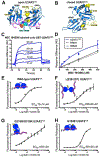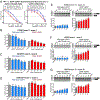A synthetic small molecule stalls pre-mRNA splicing by promoting an early-stage U2AF2-RNA complex
- PMID: 33689684
- PMCID: PMC8380659
- DOI: 10.1016/j.chembiol.2021.02.007
A synthetic small molecule stalls pre-mRNA splicing by promoting an early-stage U2AF2-RNA complex
Abstract
Dysregulated pre-mRNA splicing is an emerging Achilles heel of cancers and myelodysplasias. To expand the currently limited portfolio of small-molecule drug leads, we screened for chemical modulators of the U2AF complex, which nucleates spliceosome assembly and is mutated in myelodysplasias. A hit compound specifically enhances RNA binding by a U2AF2 subunit. Remarkably, the compound inhibits splicing of representative substrates and stalls spliceosome assembly at the stage of U2AF function. Computational docking, together with structure-guided mutagenesis, indicates that the compound bridges the tandem U2AF2 RNA recognition motifs via hydrophobic and electrostatic moieties. Cells expressing a cancer-associated U2AF1 mutant are preferentially killed by treatment with the compound. Altogether, our results highlight the potential of trapping early spliceosome assembly as an effective pharmacological means to manipulate pre-mRNA splicing. By extension, we suggest that stabilizing assembly intermediates may offer a useful approach for small-molecule inhibition of macromolecular machines.
Keywords: S34F mutant; U2AF(35); U2AF(65); U2AF1; myelodysplastic syndrome; ribonucleoprotein targeting; spliceosome inhibition; splicing factor mutation; therapeutic strategy.
Copyright © 2021 Elsevier Ltd. All rights reserved.
Conflict of interest statement
Declaration of interests The authors declare no competing interests.
Figures








Comment in
-
Stuck on UUUU: New splicing inhibitors enhance U2AF2-RNA binding.Cell Chem Biol. 2021 Aug 19;28(8):1106-1108. doi: 10.1016/j.chembiol.2021.07.021. Cell Chem Biol. 2021. PMID: 34416141
Similar articles
-
A splice site-sensing conformational switch in U2AF2 is modulated by U2AF1 and its recurrent myelodysplasia-associated mutation.Nucleic Acids Res. 2020 Jun 4;48(10):5695-5709. doi: 10.1093/nar/gkaa293. Nucleic Acids Res. 2020. PMID: 32343311 Free PMC article.
-
Mutant U2AF1-expressing cells are sensitive to pharmacological modulation of the spliceosome.Nat Commun. 2017 Jan 9;8:14060. doi: 10.1038/ncomms14060. Nat Commun. 2017. PMID: 28067246 Free PMC article.
-
HNRNPA1 promotes recognition of splice site decoys by U2AF2 in vivo.Genome Res. 2018 May;28(5):689-698. doi: 10.1101/gr.229062.117. Epub 2018 Apr 12. Genome Res. 2018. PMID: 29650551 Free PMC article.
-
Splicing Factor Mutations in Myelodysplasias: Insights from Spliceosome Structures.Trends Genet. 2017 May;33(5):336-348. doi: 10.1016/j.tig.2017.03.001. Epub 2017 Mar 31. Trends Genet. 2017. PMID: 28372848 Free PMC article. Review.
-
Role of computational and structural biology in the development of small-molecule modulators of the spliceosome.Expert Opin Drug Discov. 2022 Oct;17(10):1095-1109. doi: 10.1080/17460441.2022.2114452. Epub 2022 Aug 24. Expert Opin Drug Discov. 2022. PMID: 35983696 Review.
Cited by
-
Profiling the Binding Activities of Peptides and Inhibitors to the U2 Auxiliary Factor Homology Motif (UHM) Domains.ACS Med Chem Lett. 2023 Mar 21;14(4):450-457. doi: 10.1021/acsmedchemlett.2c00537. eCollection 2023 Apr 13. ACS Med Chem Lett. 2023. PMID: 37077390 Free PMC article.
-
Multiscale analysis and optimal glioma therapeutic candidate discovery using the CANDO platform.bioRxiv [Preprint]. 2025 May 23:2025.05.19.654757. doi: 10.1101/2025.05.19.654757. bioRxiv. 2025. PMID: 40475540 Free PMC article. Preprint.
-
Aberrant pre-mRNA processing in cancer.J Exp Med. 2024 Nov 4;221(11):e20230891. doi: 10.1084/jem.20230891. Epub 2024 Sep 24. J Exp Med. 2024. PMID: 39316554 Free PMC article. Review.
-
Multiscale Analysis and Validation of Effective Drug Combinations Targeting Driver KRAS Mutations in Non-Small Cell Lung Cancer.Int J Mol Sci. 2023 Jan 5;24(2):997. doi: 10.3390/ijms24020997. Int J Mol Sci. 2023. PMID: 36674513 Free PMC article.
-
U2AF1 in various neoplastic diseases and relevant targeted therapies for malignant cancers with complex mutations (Review).Oncol Rep. 2024 Jan;51(1):5. doi: 10.3892/or.2023.8664. Epub 2023 Nov 17. Oncol Rep. 2024. PMID: 37975232 Free PMC article. Review.
References
Publication types
MeSH terms
Substances
Grants and funding
LinkOut - more resources
Full Text Sources
Other Literature Sources

